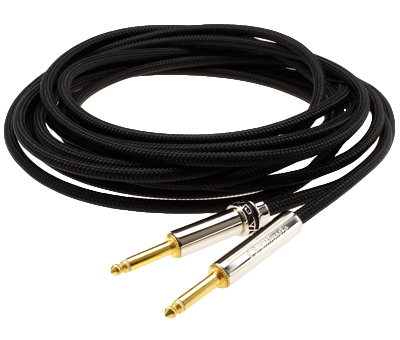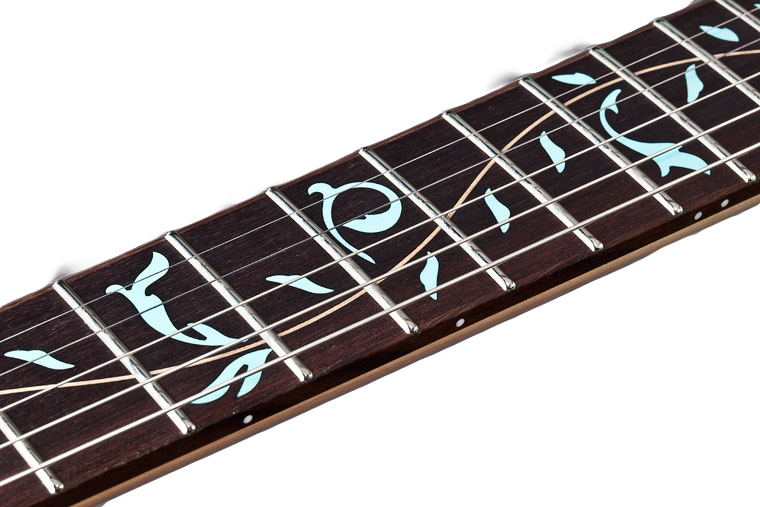Mixer Consoles
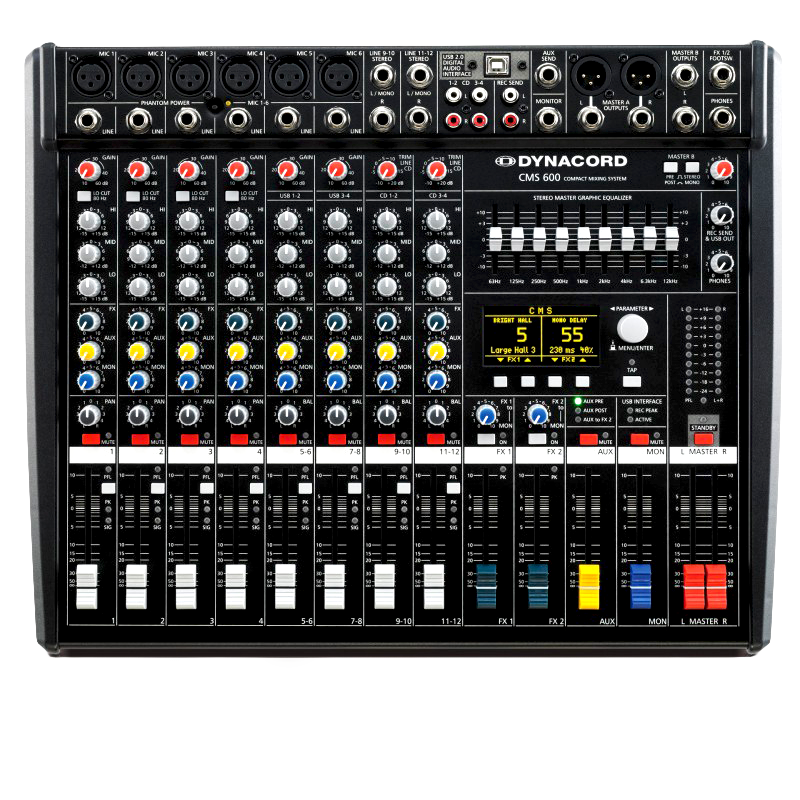
Mixer Consoles
MIXER CONSOLES

WHAT IS A MIXER CONSOLE | MIXING BOARD
If you have decided to pursue a serious career in the music industry as a professional guitarist, looking to perform live shows & record professionally, then you will definitely find yourself exposed to various mixing consoles - especially if you have chosen the electric guitar as instrument of choice, with various plugins like pedals & amps. The size of show or recording studio etc, depends heavily on the type and size of mixing console you will require for a particular event.
In sound recording, reproduction and reinforcement systems; a mixing console or board is an electronic device designed and created for combining and controlling the sounds of many different audio signals. Depending on the type of mixing board, a mixer usually has the ability to control both analog and digital signals, and are used in a vast variety of applications such as - recording studios, nightclubs, Television & Broadcasting, Live Performing stages & Venues, film post-production and more.
THE STRUCTURE: - BASICS
When purchasing your mixer board for the first time, there is going to be a lot of functions and features that will be listed. You'll need to understand the basic structure & functionality in order to make the best choice for your needs.
CHANNELS

A channel is essentially a connection or a signal path that allows a plugin to be connected & routed through it. Mixer Boards are available with various channel counts - A larger channel count allows for more plugins to be connected. Channels are normally designed to connect with microphones, amplifiers, preamplifiers, electric instruments or signal processors.
CHANNEL INPUT STRIP

A Channel input Strip is essentially a group of controls (normally displayed in vertical strip) that function together to affect the audio signals that pass through a specific channel (connection) - i.e. The channel strip for the Mic1 Channel will control the sound of the microphone that is plugged into that particular connection.
A Channel Strip usually comprises of and is grouped with the following functionalities: -
Input Jacks
- The input Jacks are sockets that allow for external instruments, microphones, pedals etc. to connect to the mixer board.Microphone Preamplifiers
- A microphone preamplifier will prepare the weaker mic signal for processing by raising it to line-level strength. (Gain)Equalization
- You will see this abbreviated as "EQ"; this will adjust the signals frequency.Dynamics Processing
- This effect can be used as a compressor, limiter or expander. When used as a compressor or limiter, it will reduce dynamic range, producing consistent volume levels. As an expander, it will increase the dynamic range by decreasing the level of low-level signals. With extreme expander settings, you can completely eliminate noise below a threshold by creating a noise gate.Routing
- Including direct-outs, auxiliary-sends and panning control. Routing essentially directs the signal to other mixer circuitry & external devices.Level Control Faders
- (On smaller sized mixers, they could be rotary knobs to save space) Faders generally slide along a track to control the input or output of a particular channel.
On most mixing consoles, these dials are colour coded to these functions for quicker identification by the user.
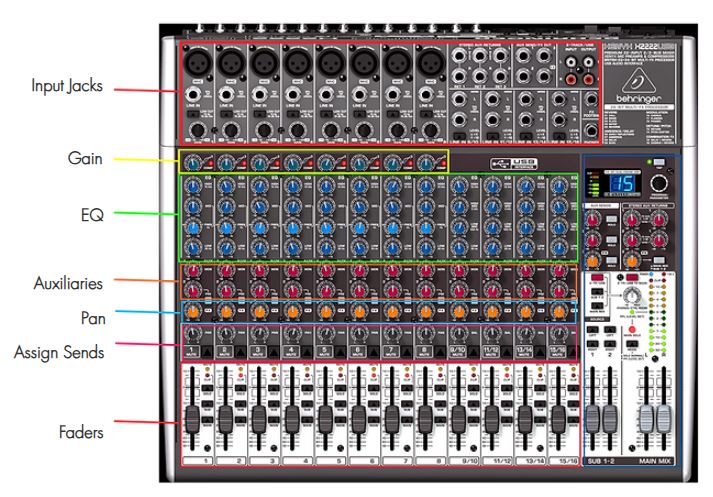
INPUTS & OUTPUTS - “I/O”
Firstly, let's understand these terms better. Input is when something is connected to a system or board with a socket designed to fit specific connections in order to achieve an output or result i.e. producing sound through various applications. Output is the information produced by a system or process from a specific input - in music, the sounds projected from applications inputted into a mixing board.
The number of inputs and outputs you'll need will completely depend on how you plan on using the mixer.
If you're a solo artist that works with backtracks rather than a full band, then your needs are far more simple. It still depends on the size of your system, but literally as a solo artist you'll generally need to cater for your guitar, microphone, amplifier, speakers, pedals and computer and this is if you have chosen the electric guitar as the instrument of choice.
A reasonable and recommended channel count for such set-up would be around 10-12 Channels. A mixer board of this size for this type of set-up would generally be suitable for small, intimate live events and basic home recording scenarios.
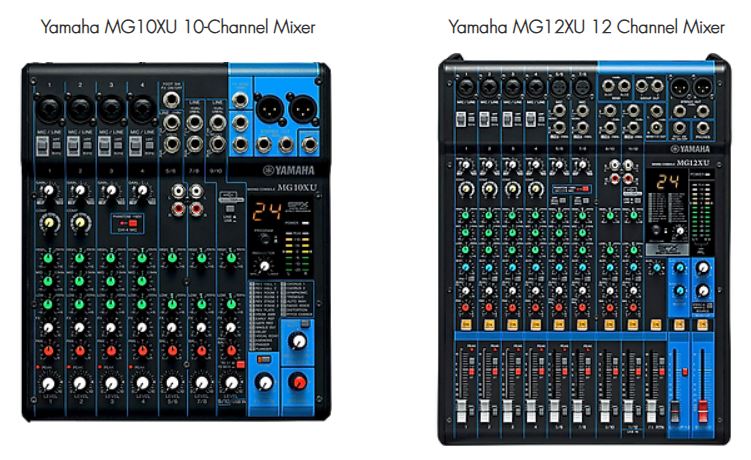
In a situation where a full band is present and are performing live; "live sound mixing", the number of instruments, microphones, amps, preamps, pedals, headphones etc. that will be used, all need to be considered - especially if the drum kit requires a few microphone channels. Generally for a 3 piece band that includes a full drum kit, bass guitar, electric guitar with vocal mic's, playing in medium to slightly bigger sized venues; a safe recommendation is a 16-18 Channel Mixer and would probably best suit this type of scenario.
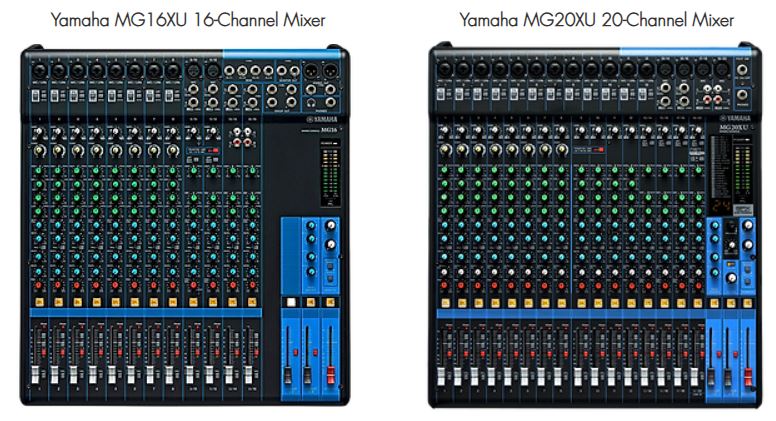
Really the size of a Mixer Board and channels you will need will completely depend on the size of your setup overall.
BUSSES - WHAT ARE THEY?
The easiest way to understand a bus, is to think of it as a "bank" or "preset". A bus is basically a path that routes one or more audio signals to a particular destination and stores the settings of these signals.
Busses are normally used to route channel signals to a main stereo or master group fader (or all), allowing you to control these signals with one fader controller. To better understand; In a live sound application scenario for example, it is better to have more busses available, as audio channels can be 'bussed' or 'grouped' together and controlled with one group fader. For example, the drum kit audio could be assigned to a single group, allowing much easier control of the overall drum sound and volume with one assigned fader. This makes things much easier for the sound engineer or person controlling the board. It lessons the number of dial pots to be controlled, and with assigned grouped controls, it makes it easier to manage sound on the go.
Mixers are available with either 2; 2/2; 4 or 8 busses supplied.
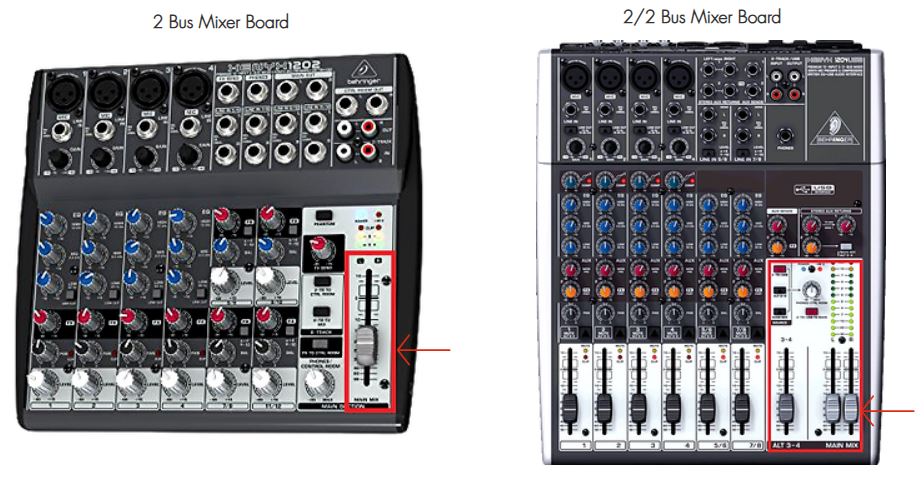
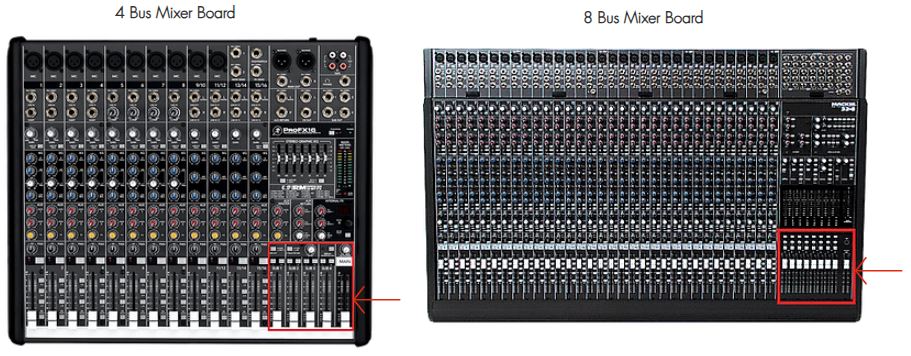
BASIC INPUT CONTROLS & INSERTS
The controls of a mixer board are designed to run in a vertical strip for easily referring of dials & controls listed for a particular plugin/insert. This is called the Channel strip as already mentioned in the beginning. The knobs or 'pots' & faders are horizontally colour coded by purpose to easily reference when making sound adjustments.
Depending on the type of mixing board, you could come across one that provides insert points grouped to a particular patchbay, after the buffer/gain stage. A channel insert allows for external processors like compressors & equalizers to connect to the mixer board for specific channels. On larger mixers, there will probably be a patchbay that allows for multiple external devices to connect.
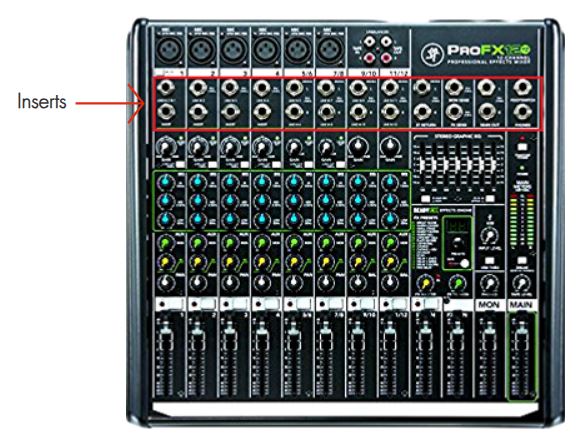
AUXILIARY SEND ROUTING - “AUX-SENDS”
An aux-send is an electronic signal-routing output used on multi-channel sound mixing consoles, and PA amplifier mixers. Basically, Aux-sends control the amount of channel signal being sent to an external device such as an effects processor.
The way it works is that you will have the ability to control the amount of effect applied to a device connected to a channel via a corresponding aux-send dial pot (knob). There are two types of aux-sends available: - pre-fader & post-fader.
Pre-fader are not affected by the main fader for the channel while post-fader sends are affected by the main fader slider for the channel.
Most mixing consoles have a group of aux-send knobs in each channel strip or on small mixers, a single knob per channel that corresponds to each aux-send on the board.
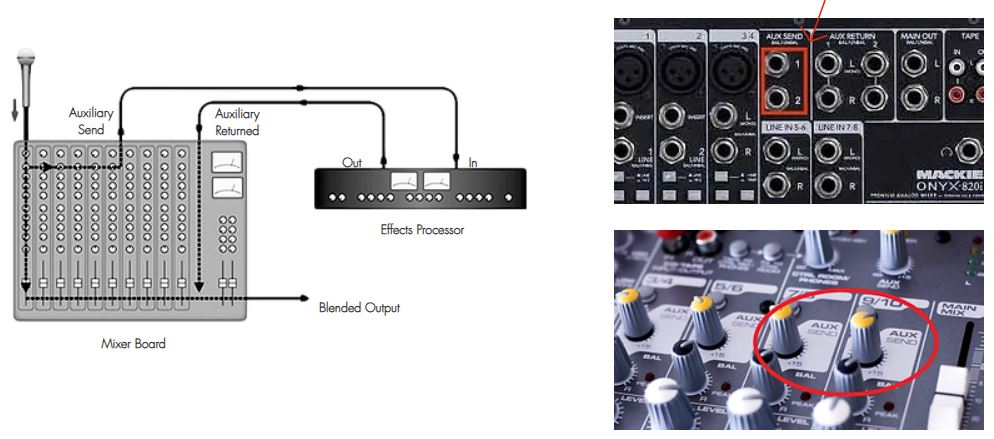
CUE SYSTEM
The Cue System gives someone (the console operator) the ability to listen to one or more signals without affecting any of the consoles audio outputs, via a set of headphones.
An example of how the cue system can be used is if the operator wanted to prepare a sound recording to cue and start at a particular point of a song, they can achieve this by utilising the cue system; and this is being done without interference to audio output with the signal from the cue system being fed to the consoles headphone amp.
The terms Pre Fade Listen (PFL) or After Fade Listen (AFL) are used to identify the point in the signal flow from which the cue signal has derived.
Pre-fader listening (PFL), allows you to hear the original signal without having to send it to a signal mix. After-fader listening (AFL) basically allows you to isolate a fader-affected signal. Consoles that have the cue feature available, will have a dedicated button for each channel, typically labeled 'Cue' or 'AFL|PLF|Solo'.
On larger consoles, you are probably going to come across the Solo in Place (SIP) feature. This feature can be destructive with live performance scenario's, as SIP literally mutes all audio output except channels being soloed. This can be a really handy and useful feature though for some situations, like live sound checks or some recording requirements.
MASTER OUTPUT CONTROLS
The Master Output Controls allows an operator to adjust the overall output audio of a mixer, typically from one fader/slider. This particular feature is once again, a very useful feature in a live sound mixing situation, where the volume of a full live band of vocalists and instruments can be adjusted as a group from one dial.
OTHER FEATURES OF SOME MIXERS
The ability to use monaural (mono) signals, (e.g. from 1/4" electric guitar input) to produce simulated stereo sound through 'pan' and 'balance' controls.
Note:
- 'Monaural' - mono, is sound intended to be heard as if it were emanating from one place.
- 'Panning' - panning is the distribution of a sound signal into a new stereo or multi-channel sound field, creating the impression that a sound source is moving from one side of the soundstage (or recording facilities) to the other, controlled by a dedicated pan control setting.
Some consoles provide phantom power which is a requirement for some capacitors and condenser microphones.
But what is phantom power? Phantom Power is DC electric power transmitted through microphone cables to operate
microphones that contain active electronic circuitry. Basically, a convenient power source for condenser microphones
and some capacitors.
Some Consoles have the ability to: -
Add onboard external effects units (reverb, delay, echo etc.)
Create an audible test tone via an oscillator - used to test channels & check functionality.
Can be interfaced with computers or other recording equipment.
Control or be controlled by a digital workstation via midi or proprietary commands.
ANALOG vs DIGITAL vs SOFTWARE MIXERS
Analog mixers are the originals and was first introduced with audio recordings and PA systems in the very beginning, while digital mixers made their appearance in the 1990's, introducing new technology that in theory provided more functionality. As technology continued to grow and the development & increase in computer usage grew, so did the enhancements of mixing consoles & software-based mixing was then also introduced to keep up with the technological demands of an era where computers have become a main source for most things.
ANALOG MIXERS
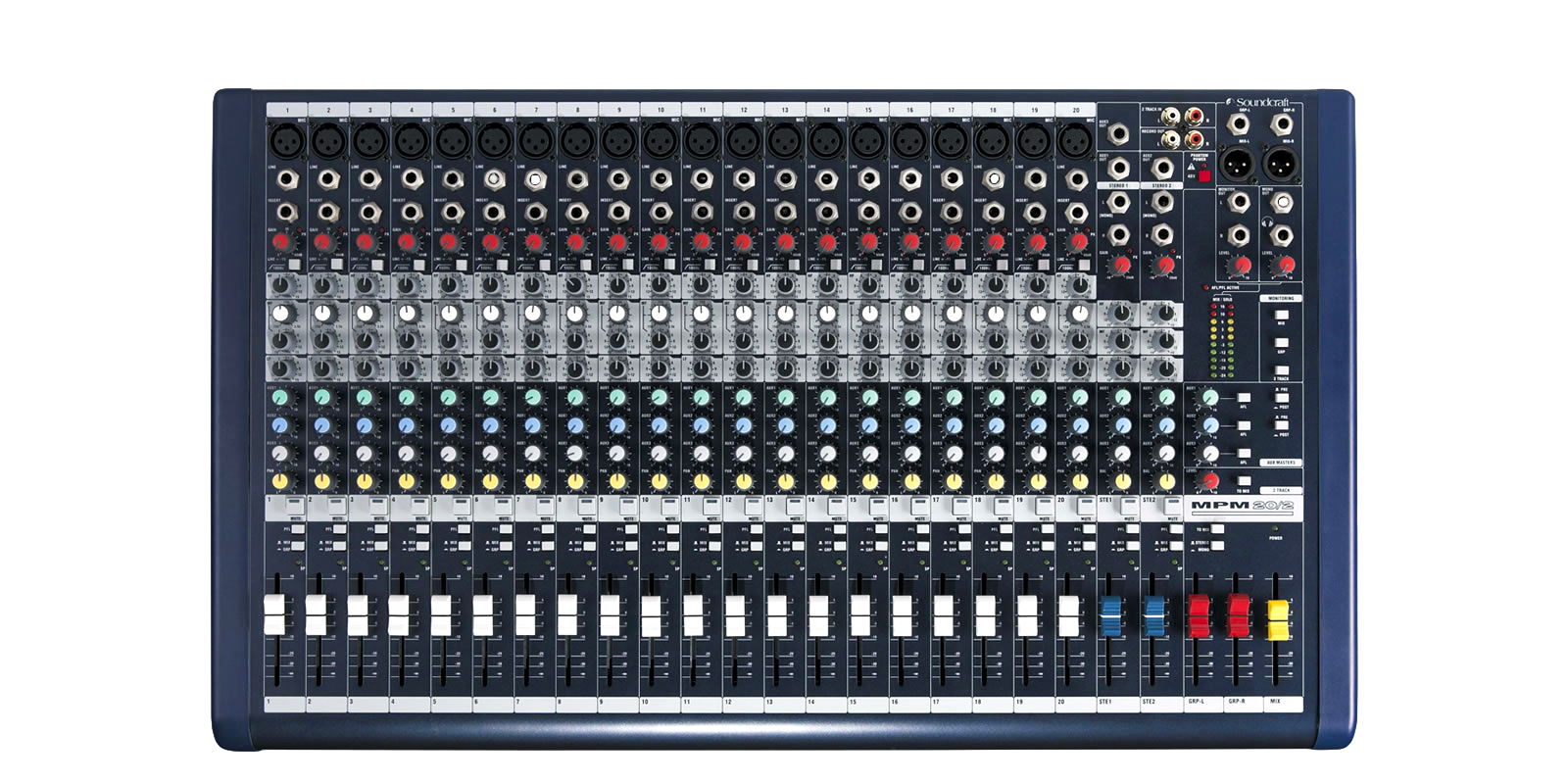
Analog Mixers remain popular still today, even with the digital competitor that has greater versatility. This is mainly due to the simplicity of an analog layout, overall operational functionality and cost. An analog mixer has a layout that is logical and simple for most users. The 'Channel Strip' has a column of dedicated dials, knobs, switches and faders for a specific channel, with dials colour coded to functionality.
Sound engineers have been trained on analog mixers & layouts for generations and prefer the simplicity to digital banks of stored info to search through in hidden menu's etc. Analog mixers will likely remain a popular choice for some time still.
An analog mixer would generally take up more space with the design and dials placed, than that of a digital board, but can accommodate rapid responses to changing performance conditions.
DIGITAL MIXERS
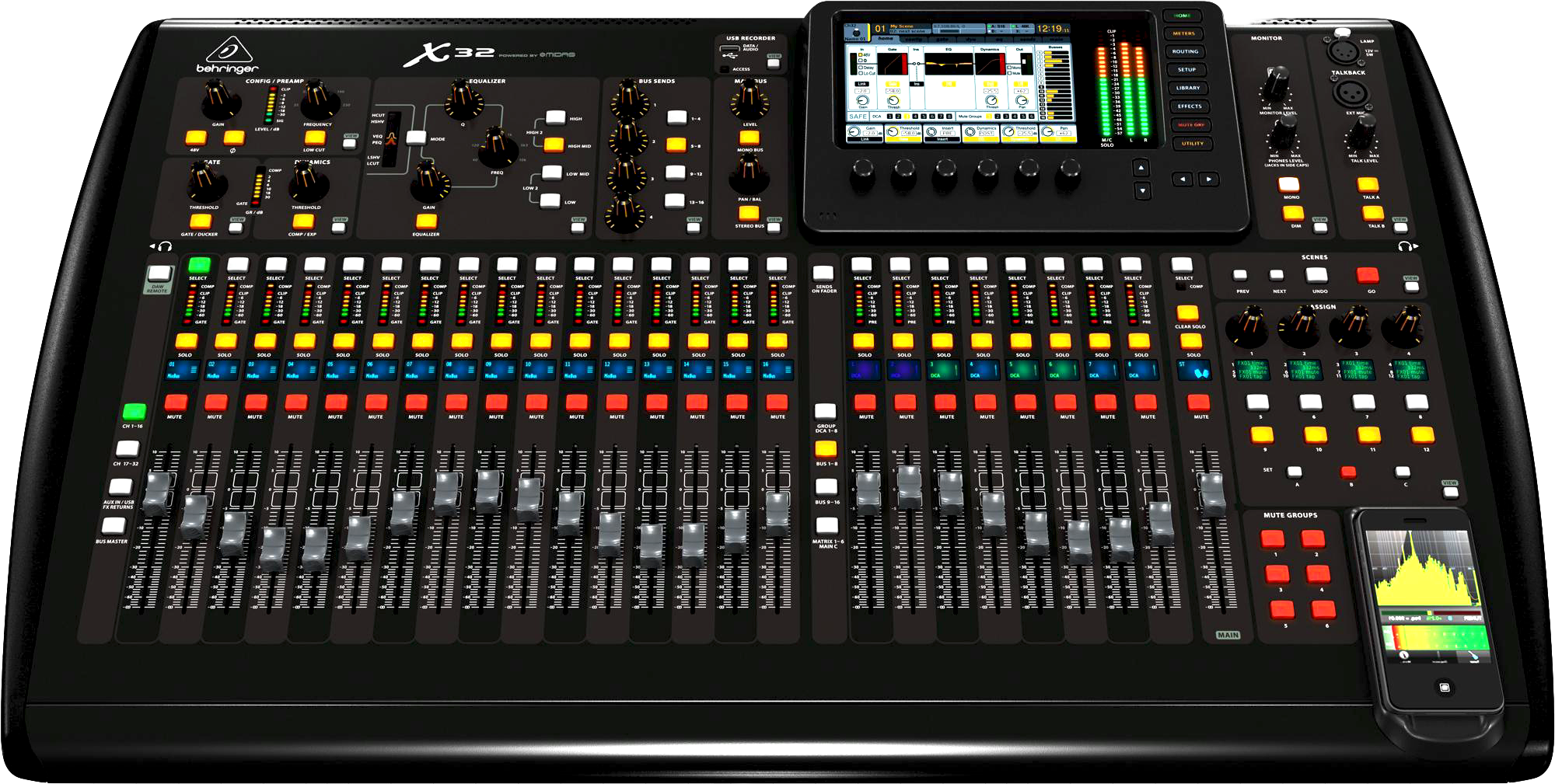
Digital Mixer sales are increasing as new technology continues to be developed and released. Digital Mixers are far more versatile and offer a much larger range of new features compared to Analog.
Some Features include: -
The ability to reconfigure routing at the touch of a button.
Processing capabilities like compression, gating, reverb, automatic feedback suppression and delay.
Digital mixers offer a large variety of effects possibilities; flexible & extensive signal dynamics as well as pre- programmable routing & effects. Some digital consoles may even have the ability and be compatible to plug-in with softwares that could further enhance tone-shape - making a digital mixers functionality hard for analog mixers to beat.
Digital Mixers are still more complicated to operate though, but once you learn to use them properly you can really create some amazing sounds and effects, that can actually be easily managed if you understand how.
Both analog and digital mixers produce high quality sound, as both rely on analog microphone preamplifiers (a high gain circuit that increases the low signal level from a microphone to a level that is better matched to the consoles internal operating level.)
Another big advantage to digital mixers is the ability to save and recall mixes. This is a particularly awesome feature for live performance setups, as you'll have the ability to save a sound for specific venue types and then recall them at similar venues; saving you tons of time on sound mixing and simplifying your setup process overall.
SOFTWARE MIXERS - (COMPUTER BASED)
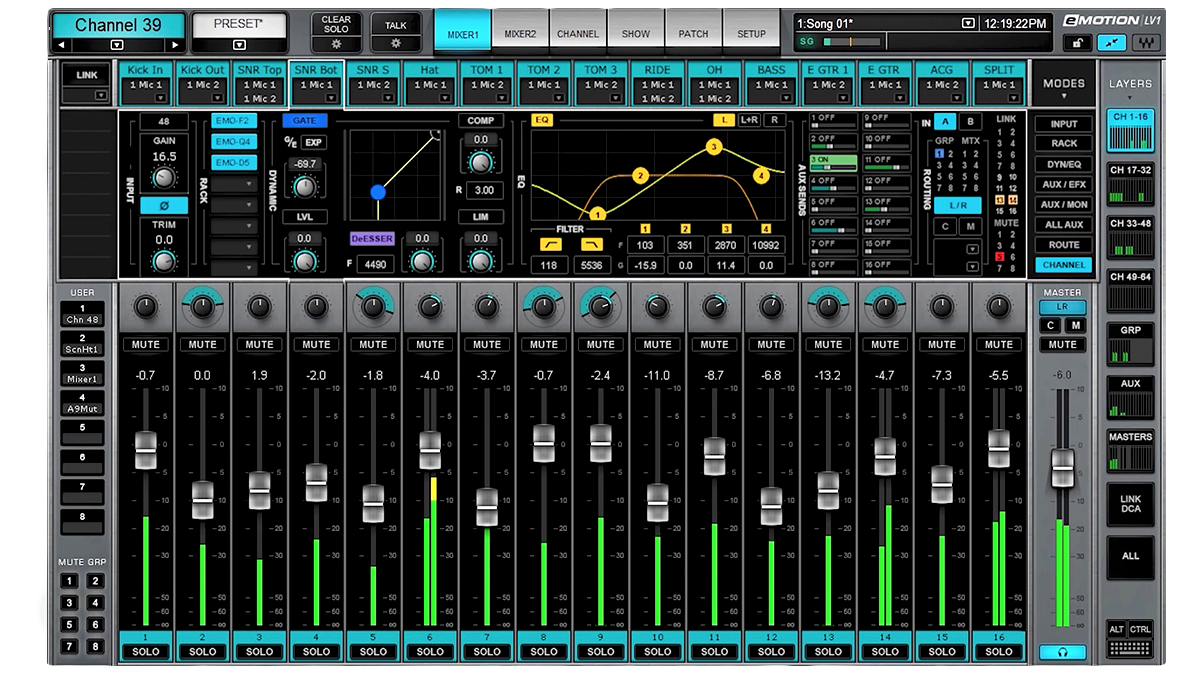
Software Mixers are completely computer based and controls are provided within a computerized program interface, that is either hosted via laptop, computer or software compatible electronic devices.
Most commonly used for recording, software mixers allow an operator the ability to easily integrate virtual instruments, drum loops and many more effects into the music production process.
Software applications can be overwhelming at first, as there are many functions and features to learn, but once you fully understand the functionality of a software mixer, it really does provide so many sound and tone possibilities in terms of a recordings production and the enhancements brought through in the recording.
If you chose to use a Software mixing application for live performing scenarios, then a suitably configured laptop, mixing software and compact control surface will give you what you need by way of signal processing and routing, without the larger space and budget concerns of a standard analog and digital mixer.
POWERED MIXERS
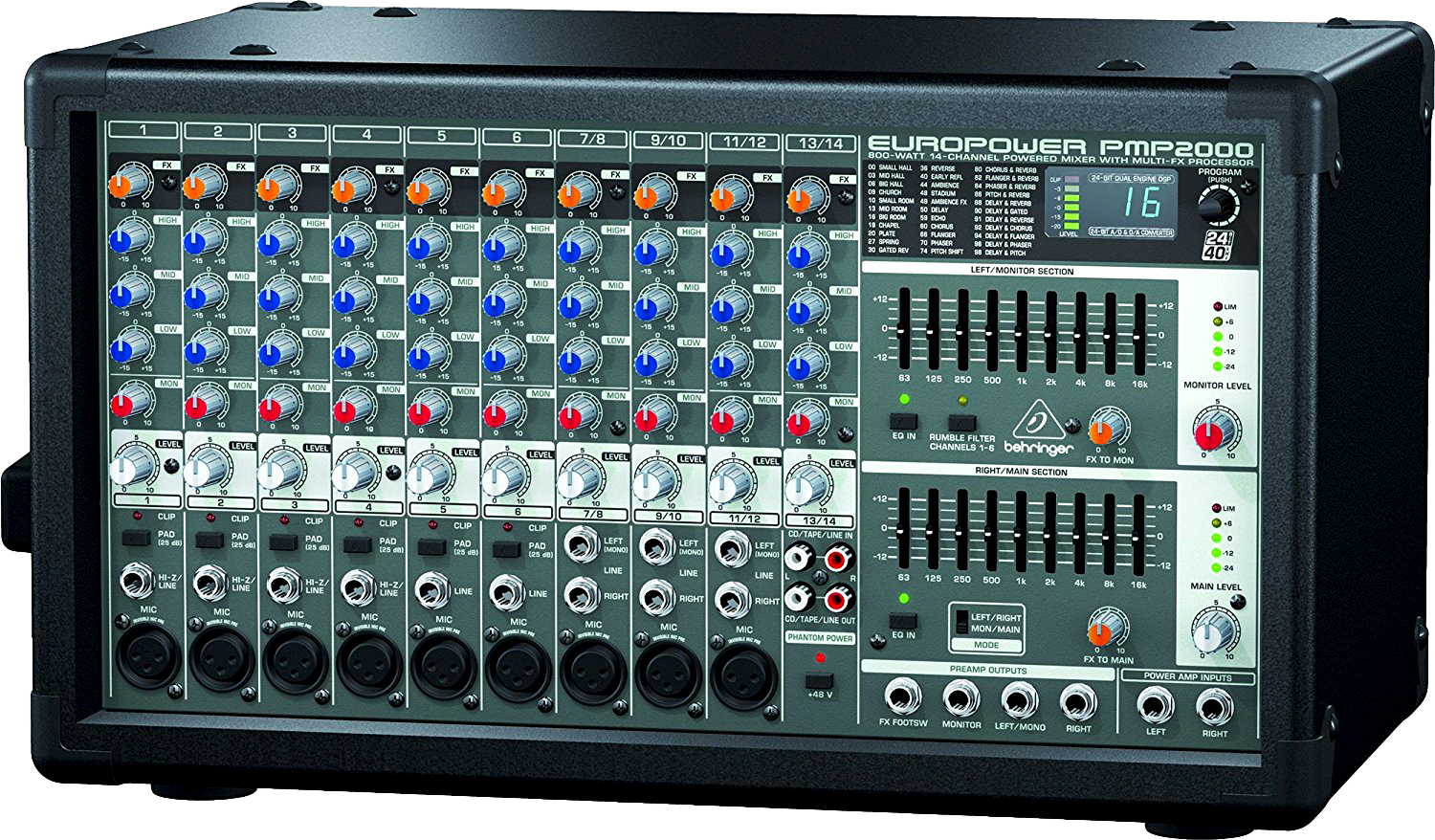
Basically a powered mixer is a two in one device that provides the ability to power main and monitor speakers that are unpowered, eliminating the need to transport extra power amplifiers when setting up for live performances, while still providing the functions required of an analog mixing console.
Because powered mixers are available in various sizes with different specifications and configurations, they have the capabilities and requirements needed to handle solo singer-guitarist artists with a 2 mic set up to a full band with different instruments, amplifiers, microphones and hefty speakers.
Powered mixers can be really convenient for solo artists, carrying and setting up themselves - less equipment and set up requirements can make the entire set up process much easier.
TOP 5 MIXING CONSOLE MANUFACTURERS
1.

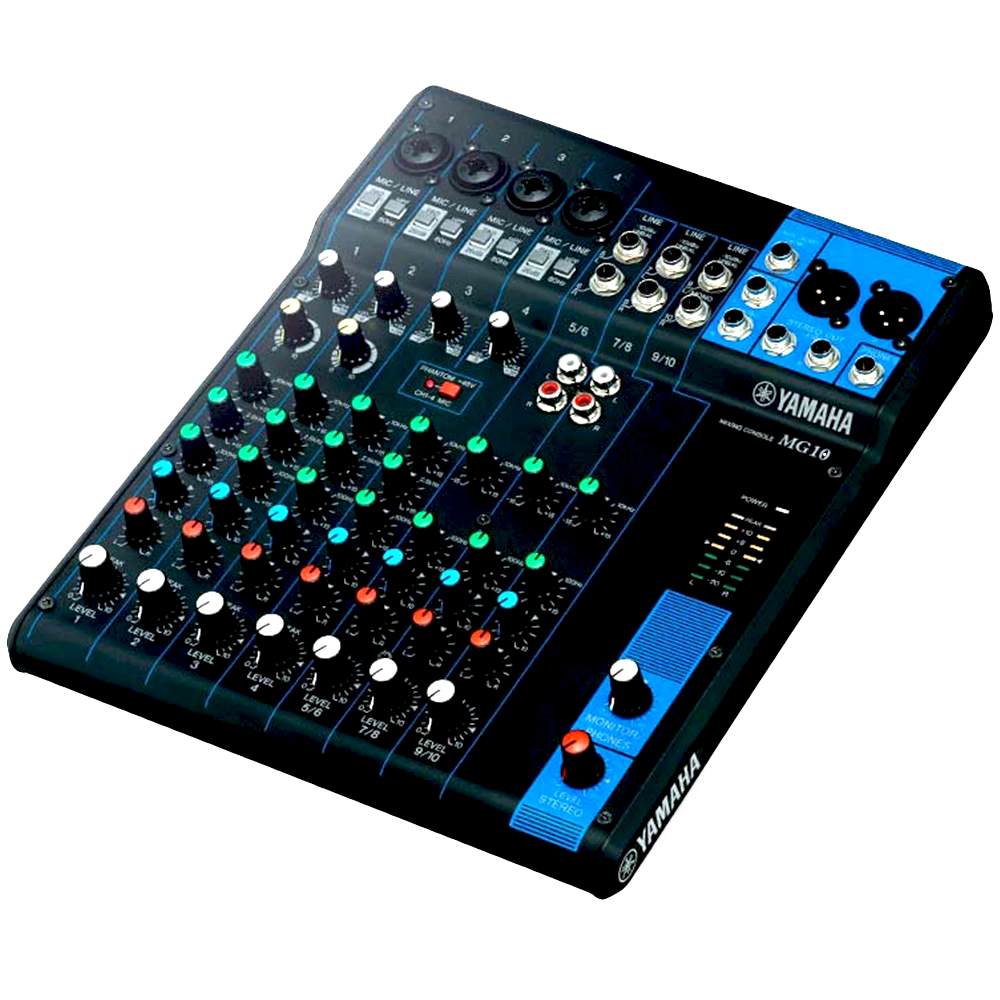
Yamaha Corporation is a Japanese multinational corporation and conglomerate with a very wide range of products and services, predominantly musical instruments, electronics and power sports equipment.
2.
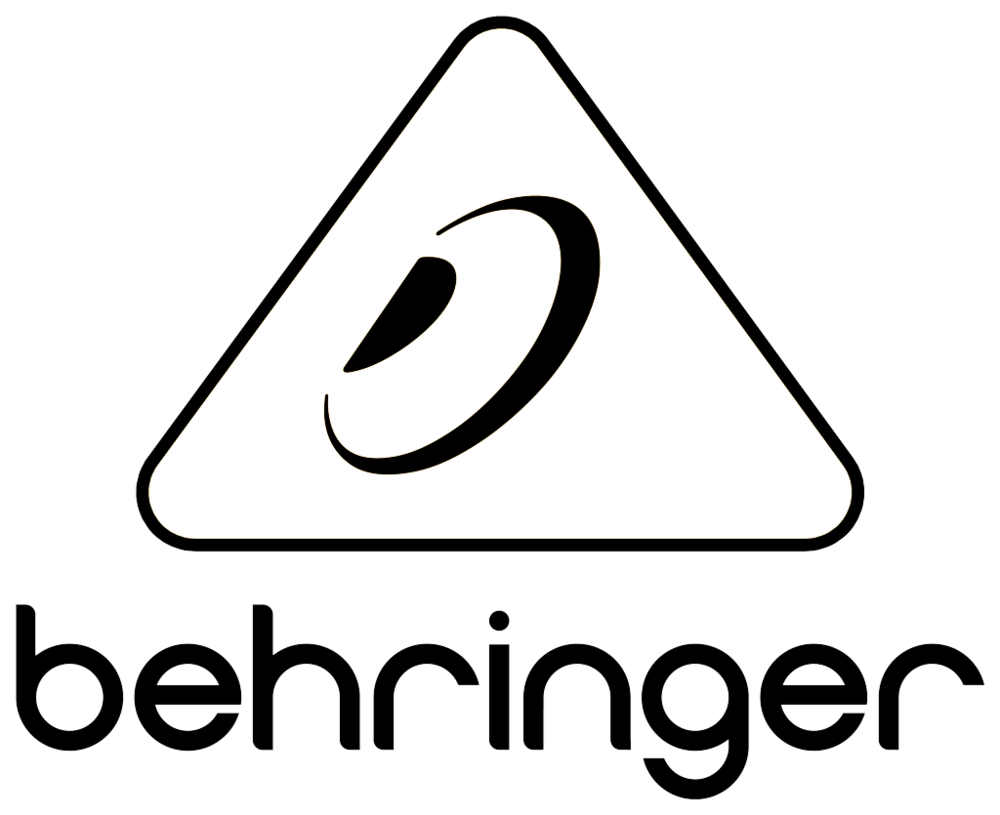

Behringer is an audio equipment company founded by the Swiss engineer Uli Behringer in 1989, in Willich, Germany. Behringer was listed as the 14th largest manufacturer of music products in 2007.
3.

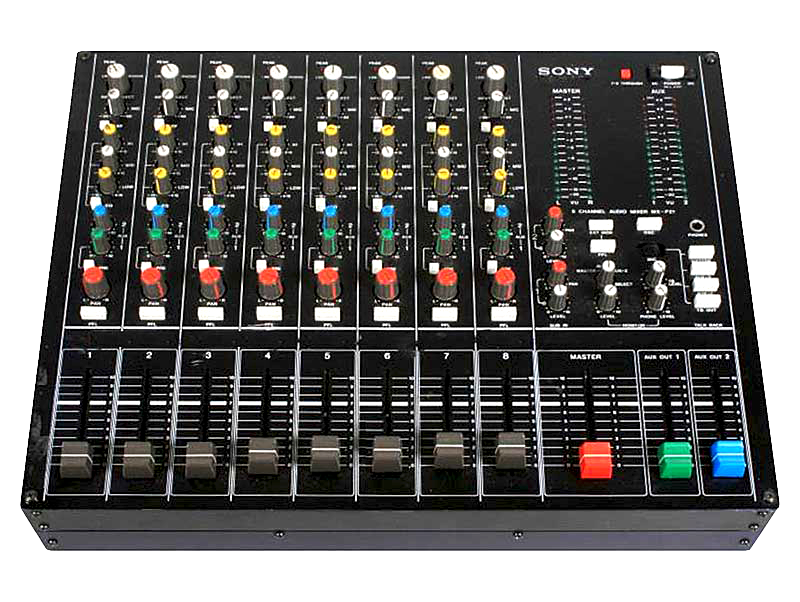
Sony Corporation is the electronics business unit and the parent company of the Sony Group. The group consists of Sony Corporation, Sony Pictures, Sony Mobile, Sony Interactive Entertainment, Sony Music, Sony Financial Holdings and others.
4.


PreSonus Audio Electronics, Inc. (often known and styled as PreSonus) is an American manufacturer of audio and digital audio workstation (DAW) equipment and software, used to create, record, mix, and master music and other audio.
5.

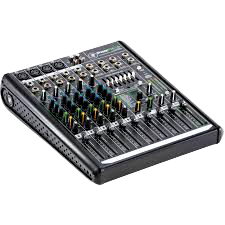
Mackie Designs was founded in Seattle by Greg Mackie and designed and manufactured affordable and versatile compact pro audio mixers. Mackie is now a brand of LOUD Technologies. The Mackie brand is used on professional music and recording equipment, such as mixing consoles, loudspeakers, studio monitors and DAW control surfaces, digital recording equipment and more.



